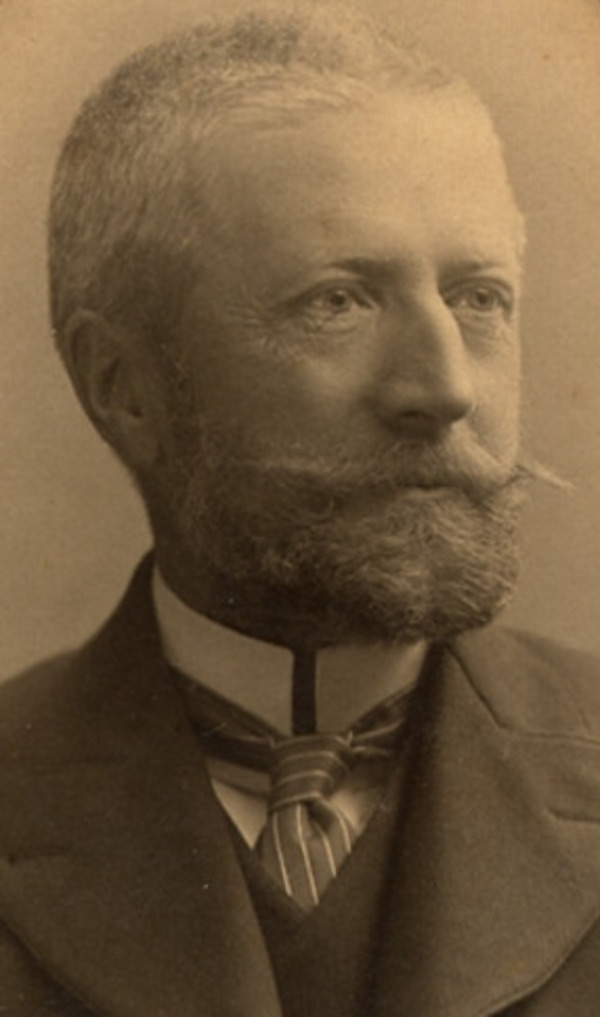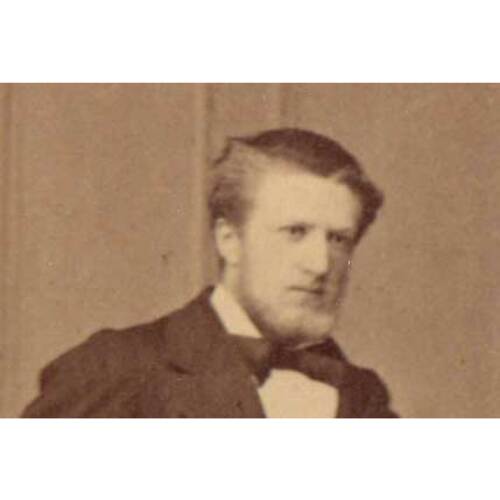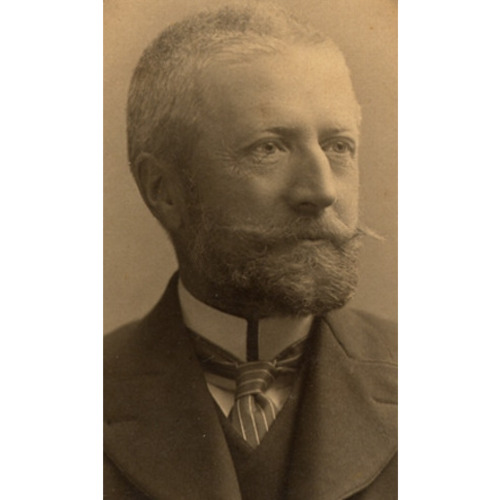
Source: Link
OBALSKI, JOSEPH (named at birth Joseph-François-Jacques-Victor), mining engineer, civil servant, professor, and author; b. 14 Sept. 1852 in Châteaubriant, France, son of Joseph Obalski, a road surveyor of Polish origin, and Sophie Lhénoret, from Nantes; m. 5 July 1882 at Quebec Joséphine Gosselin (d. 1 Feb. 1934), and they had two daughters; d. 25 March 1915 in Montreal.
Probably the eldest in a family of at least six, Joseph Obalski grew up in the eastern part of Brittany, a region known for its iron mines and metallurgical industry. This environment may explain why he sought a career as a mining engineer. He graduated from the École Nationale Supérieure des Mines de Paris in 1877 and completed his training with courses in engineering. Several years later he met the premier of Quebec, Joseph-Adolphe Chapleau*, who was on holiday in France from July to September 1881. Chapleau offered him the post of provincial mining engineer with an annual salary of $2,000 and the payment of his travel expenses from France to Quebec. Obalski accepted, and by November he was at work in the Department of Railways, which Chapleau headed, even though mining activities came under the Department of Crown Lands.
Obalski arrived at a time when, on Chapleau’s initiative, economic and political ties between France and Quebec were being renewed and when the province had just passed its first general statute on mining. The adoption of the legislation in 1880 followed a major upsurge in the industry during the late 1870s, especially in the sectors of asbestos and phosphates. The government needed at least one professional civil servant to administer the law, and the task fell to Obalski.
He was first deputed by Chapleau to prepare an organizational plan for a mines branch. In January 1882 he presented one containing what he considered the essential elements of a good mining administration. He proposed that an engineer head it, with responsibility for general supervision of mines, and in particular the granting of mineral rights; for intervention when poor working conditions endangered the lives of employees; and for the gathering of information from mine operators about production, the number of employees and days worked, and the frequency and nature of accidents. His plan included the services of an assay laboratory, which could be that of the École Polytechnique in Montreal, an assistant for the office and for field explorations, and the expansion of instruction in mining engineering. Obalski further recommended that the Department of Crown Lands continue to administer permits and mining rights. After Chapleau’s departure in 1882, Obalski was attached to this department, although he retained a great deal of autonomy.
As head of the mines branch, Obalski himself undertook field exploration on numerous occasions, as well as examination of samples and of the results of laboratory analysis to assess the commercial potential in the deposits; he reported his findings to either the minister or private interests. He also drew up more general accounts, a number of which appeared in the annual report of the commissioner of crown lands or in other publications. For example, in 1889 he published Mines et minéraux de la province de Québec, a work largely modelled on a federal one by Robert Wheelock Ells. He contributed studies on chromite (1898), gold (1898), and mica (1901), as well as pamphlets for international exhibitions such as those at Chicago in 1893, Paris in 1900, and Liège in 1905.
Obalski had visited the École Polytechnique in Montreal early in 1882 and had realized it was important to develop the teaching of geology, mineralogy, and mining there. At the request of the school’s principal, Urgel-Eugène Archambeault*, Chapleau had Obalski named professor in July 1882. From the fall of that year Obalski taught several courses a week; however, he was forced to give up this work in the fall of 1884 because the school stated that it could not cover his travel costs from Quebec City to Montreal. The government had paid these expenses until the end of 1883, at which point it was no longer willing to do so. Experiencing financial difficulties, the school could not assume the responsibility. But in 1885 Obalski settled in Montreal with his family, including his mother-in-law, and he resumed teaching in the autumn. Although he gave it up in 1888, Obalski maintained strong links with the school, especially with its laboratory but also with its staff and students. Later he would be named honorary professor, but hopes that he would return to teach never materialized.
In 1886 Obalski’s position in the government was also thrown into question. The terms of his contract were changed and he became an occasional employee with a per diem of ten dollars and travel expenses. Experience showed this arrangement was significantly less advantageous for him. He therefore petitioned Honoré Mercier*’s administration, which came to power in January 1887, for a permanent, full-time position again. On 18 April 1888, by order in council, he was once more put on the list of “permanent officers” with a salary retroactive to 1 July 1887 (less the fees he had received) and was required to reside in Quebec City or its environs. Around the same time the government added to his duties that of inspector of gold-mines.
In 1891 the Mercier government reorganized the mines branch, turning it into the Bureau of Mines, with more personnel, a larger budget, and a network of regional inspectors. Obalski was involved in drawing up the details of the new organization. As a result of the changes he finally obtained a clerk and a secretary to assist him in running the bureau. None the less, soon after the Conservatives’ return to power late in 1891, budgetary considerations reversed the situation, and Obalski found himself the only inspector for the province, though he retained a secretary for administrative matters. He continued his career in this way until 1905, when he was appointed the first superintendent of mines. A period of considerable growth for the service was beginning, which would be marked by the hiring of clerks, a civil engineer, a messenger, and a new administrative secretary. Obalski promoted mining development in several regions of the province, in particular around Lac Chibougamau, which he visited in 1904, and in the northwest, where he went several times between 1906 and 1909.
Weary of travelling and field exploration, Obalski retired in 1909 after more than 27 years of service (he was deemed for pension purposes to have served 35). He had made a formative contribution to the development of mining and mining engineering in Quebec. For a while he pursued a career in Montreal as a consulting engineer associated with Émile Dulieux, a young man also of French origin, who was a professor at the École Polytechnique and directed its chemistry laboratory. In addition, Obalski played an important role in the French community of Montreal as president of the Chambre de Commerce Française and a member of the Union Nationale Française. He died in the city on 25 March 1915 after a short illness. His burial took place on the 29th, the funeral being attended by numerous politicians and businessmen. To mark his contribution to the development of the Lac Chibougamau region, his name was given to the township where the lake is located.
ANQ-Q, CE1-1, 5 juill. 1882, 29 mars 1915; E5/79, 1881, no.423; 1882, no.274; 1888, no.231; 1909, no.421; E20/385, Joseph Obalski à J.-A. Chapleau, 25 janv. 1882; Obalski à Pierre Garneau, 3, 31 mars, 2, 14 avril 1888; Obalski à E.-E. Taché, 12 mai, 25 juill. 1888. Arch. de l’École Polytechnique de Montréal, Dossier Joseph Obalski. Arch. Départementales, Loire-Atlantique (Nantes, France), Châteaubriant, 14 sept. 1852. Montreal Daily Star, 26 March 1915. La Patrie, 26 mars 1915. La Presse, 26, 29 mars 1915. Le Soleil, 27 mars 1915. Robert Gagnon et A. J. Ross, Histoire de l’École polytechnique de Montréal, 1873–1990; la montée des ingénieurs francophones (Montréal, 1991). [Olivier Maurault], L’École polytechnique de Montréal, 1873–1948 (Montréal, 1948). Marc Vallières, Des mines et des hommes; histoire de l’industrie minérale québécoise; des origines au début des années 1980 (Québec, 1989).
Cite This Article
Marc Vallières, “OBALSKI, JOSEPH (Joseph-François-Jacques-Victor),” in Dictionary of Canadian Biography, vol. 14, University of Toronto/Université Laval, 2003–, accessed December 17, 2025, https://www.biographi.ca/en/bio/obalski_joseph_14E.html.
The citation above shows the format for footnotes and endnotes according to the Chicago manual of style (16th edition). Information to be used in other citation formats:
| Permalink: | https://www.biographi.ca/en/bio/obalski_joseph_14E.html |
| Author of Article: | Marc Vallières |
| Title of Article: | OBALSKI, JOSEPH (Joseph-François-Jacques-Victor) |
| Publication Name: | Dictionary of Canadian Biography, vol. 14 |
| Publisher: | University of Toronto/Université Laval |
| Year of publication: | 1998 |
| Year of revision: | 1998 |
| Access Date: | December 17, 2025 |




